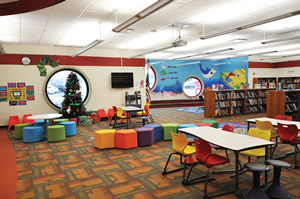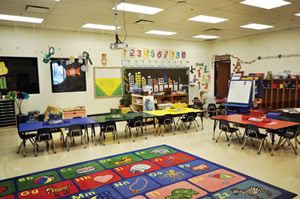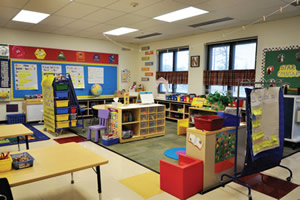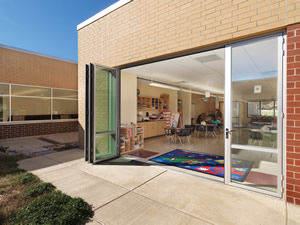Early Childhood Learning Spaces

PHOTO COURTESY OF LARSON & DARBY GROUP
Today, the push for educational engagement has changed direction and there is a fresh focus on early childhood education, or pre-K/Kindergarten kids. Once a child turns age three, many parents are choosing to enroll them in a half or full-day pre-K early childhood program. These parents are looking for more than traditional day care. They want their little students to be engaged, interacting and learning beyond the usual PBS program or educational toy. Some want their young ones tested for any possible developmental issues or special needs, so they can be addressed and get a head start on helping to overcome these challenges and catch up to their peers.
It is more important than ever for school districts, administrators and educational designers/architects to reevaluate the traditional pre-K or kindergarten classroom to provide more creative, engaging and specialized early childhood learning spaces. One significant factor in designing these spaces is whether or not it is a “Pre-School for All” program. If it is, there are extensive list guidelines and regulations that must be considered and followed. If it is not a “Pre-School for All” program there will be more flexibility in designing more customized classroom spaces.

PHOTO COURTESY OF LARSON & DARBY GROUP
One major difference in current early childhood educational programs, compared to traditional pre-K programs, is that its curriculum and classroom environment consists of “Project-Based Learning.” In the past, “themes” were typically used, like “trees” or “water” in the educational delivery. With project-based learning, a theme like “trees” is now incorporated into multiple areas of educational engagement. According to Mrs. Marijo Schwartz, Early Childhood Coordinator at Sycamore (Illinois) Community School District 427, these areas might include an art space, a physical dramatic play station, a hands-on experiential learning station, a sensory zone or a reading center. Peer modelling is also being used in early childhood classrooms. This is where a student is paired with a special needs student to learn from each other’s behaviors and efforts.
The current trends for early childhood educational spaces include zoned areas in the classroom to accommodate all the project-based learning approaches. For example, one area of the classroom might host hands-on learning stations, with a large interactive touch screen table, for basic science learning opportunities. Another area could be set up as a mini stage or performance area to accommodate dramatic play and interaction. An art project area could also be set up for student creativity. In yet another area, there could be a sensory zone where students can either have experiential opportunities or can relax and calm down from a stimulating activity. And there could still be the more standard “centers” or gathering areas to accommodate story time, educational games and more.

PHOTO COURTESY OF LARSON & DARBY GROUP
Furniture and equipment choices play a very integral role in helping to create and define the various zones within the classroom. These days, there are countless furniture and equipment options on the market, allowing for a variety of choices that are flexible and provide different seating and learning opportunities. A good early childhood educational space might include cube chairs, a curved and soft couch, rifton chairs, half circle chairs, standard age appropriate stackable chairs, bean bags and pillows, or even a small fidget bar desk/table. It is important to have these varied seating options to help facilitate and accommodate the various learning styles and needs of the students. It is also important to ensure all the furniture be age appropriate in size and style. Low shelving units and storage areas allow easy access for young students to get what they need in order to learn, and also aid with better unobstructed visual line of sight for classroom supervision.

PHOTO COURTESY OF LARSON & DARBY GROUP
Project-based kindergarten. The current trends for early childhood educational spaces include zoned areas in the classroom to accommodate all the project-based learning approaches. In the photo above, from Harrison Community Learning Center for Peoria Public Schools District 150 in Peoria, Ill., these spaces also include outdoor classroom areas. In the other images, from Country Trails Elementary School in Central School District 301 Burlington, Ill., areas are designed to provide hands-on learning stations, large interactive touch screen tables, and even space for a mini stage or performance area.
Other aspects that are integral to a well-designed early childhood classroom are the environmental aspects. Studies have shown students learn better with natural light, so it’s important to incorporate natural daylight whenever possible. Environmental HVAC control options should also be incorporated to maintain a comfortable room temperature. Controlled lighting zones with dimming capabilities is also very important for classrooms, especially in sensory zone areas. Walls should consist of bright primary colors in lieu of standard white/beige walls, but should only be used as accent colors to avoid over stimulating students. Vibrant colors also can be worked into the overall design via the selection of flooring materials, cabinetry and furniture. Some undesignated open space between zones also is desirable.
It’s also important to accommodate mobility and large motor skill activities outside the classroom. As a result, there should be direct access to areas outside the classroom such as a track or loop, and an age-appropriate playground located in a contained area having soft landing or base material.
From color to lighting controls, to unique furnishings and designing learning zones for project-based learning, there are many prime factors that play an integral role in creating a successful 21st-century early childhood educational classroom environment.
This article originally appeared in the School Planning & Management January 2018 issue of Spaces4Learning.
About the Author
Stephen Nelson AIA, LEED-AP, is director of Educational Architecture with Larson & Darby Group, vice president of the Sycamore (Ill.)SD427 Board of Education and serves on the Kishwaukee Division Exec Board and the Service Associates Executive Board of the Illinois Association of School.